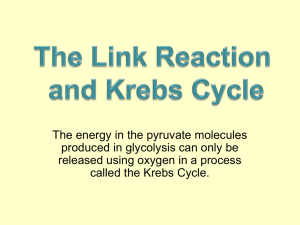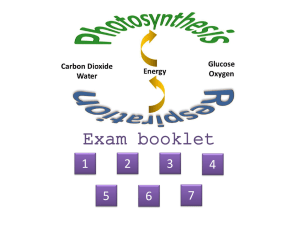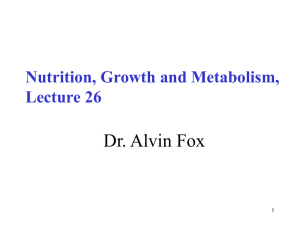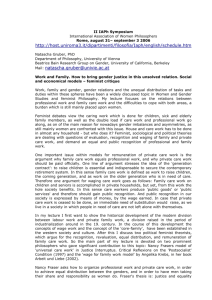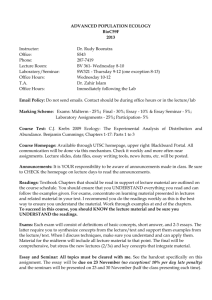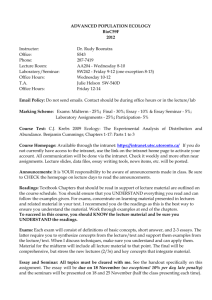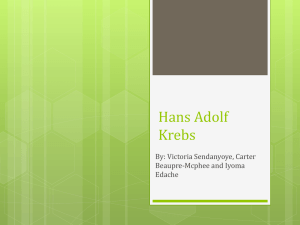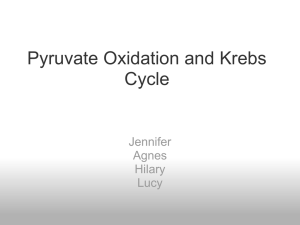A2 4.1.1 Krebs Cycle
advertisement
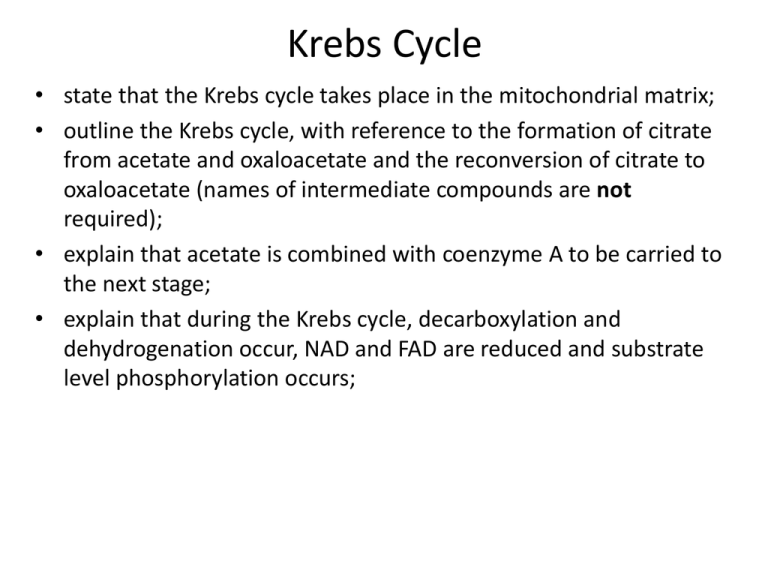
Krebs Cycle • state that the Krebs cycle takes place in the mitochondrial matrix; • outline the Krebs cycle, with reference to the formation of citrate from acetate and oxaloacetate and the reconversion of citrate to oxaloacetate (names of intermediate compounds are not required); • explain that acetate is combined with coenzyme A to be carried to the next stage; • explain that during the Krebs cycle, decarboxylation and dehydrogenation occur, NAD and FAD are reduced and substrate level phosphorylation occurs; Respiration: The 4 Parts Respiration consists of 4 parts: • Glycolysis • Link Reaction • Krebs Cycle • Oxidative Phosphorylation (the electron transport chain) The Krebs Cycle is the Third Stage of Aerobic Respiration • The krebs cycle takes place in the matrix of the mitochondria. • It happens once for each pyruvate molecule made in glycolysis, and so it goes round twice for every glucose molecule that enters the respiration pathway Acetyl CoA ATP 4- carbon compound ADP + Pi oxaloacetate NADH 4C 2C CoA 6- carbon compound NAD citrate FADH 6C FAD CO2 5- carbon compound NADH NAD 5C CO2 1C NAD NADH 1C The Krebs Cycle • Acetyl co enzyme A from the link reaction combines with oxaloacetate to form citrate • Coenzyme A is released back to the link reaction to be used again • The 6-carbon citrate molecule is decarboxylated (loses CO2) to give a 5-carbon molecule • Both citrate and the 5-carbon molecule formed from it are also dehydrogenated (lose hydrogen) in the cycle, to reduce the coenzymes NAD and FAD (flavin adenine dinucleotide) The Krebs Cycle • Overall, 3 reduced NAD+ and 1 reduced FAD are produced. These coenzymes can now be used to carry the hydrogen to the electron transport chain • The 5 carbon compound is decarboxylated, bringing you back to 4-carbon oxaloacetate. ATP and CO2 are released Products of the Krebs Cycle enter the final Stage of Aerobic Respiration • Some products are reused, some are released and others are used in the final stage, oxidative phosphorylation: the electron transport chain… • There is one turn of the Krebs cycle for each molecule of acetate, which was made from one molecule of pyruvate. Therefore there are two turns of the cycle for each molecule of glucose Products of the Krebs Cycle enter the final Stage of Aerobic Respiration • One coA is reused in the next link reaction • Oxaloacetate is regenerated so it can be reused in the next krebs cycle • Two carbon dioxide molecules are released as a waste product of respiration • One molecule of ATP is made per turn of the cycle- by substrate level phosphorylation • Three reduced NAD and one reduced FAD co-enzymes are made and enter the electron transport chain Substrate-level phosphorylation is a type of chemical reaction that results in the formation and creation of adenosine triphosphate (ATP) by the direct transfer and donation of a phosphoryl (PO3) group to adenosine diphosphate (ADP) Krebs Questions 1. Why do living organisms only have a small amount of oxaloacetate in their cells? 2. Explain why each stage of the Krebs cycle needs to be catalysed by its own specific enzyme 3. State the role of pyruvate dehydrogenase Krebs Questions 1. Why do living organisms only have a small amount of oxaloacetate in their cells? It is constantly being regenerated 2. Explain why each stage of the Krebs cycle needs to be catalysed by its own specific enzyme each substrate needs it’s own enzyme with a specifically shaped active site that is complementary to the substrate 3. State the role of pyruvate dehydrogenase it removes hydrogen from pyruvate Task • Now try to draw glycolysis, the link reaction and the Krebs Cycle on A3 with no notes
